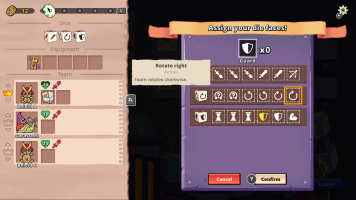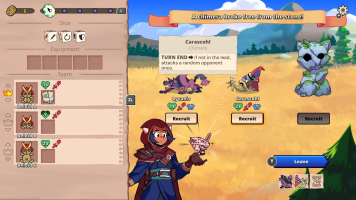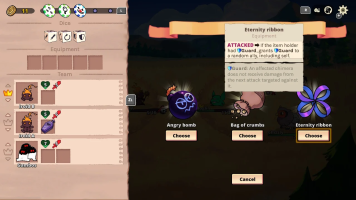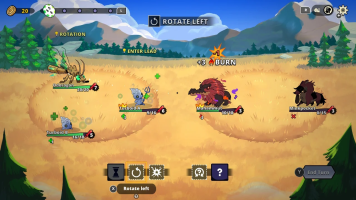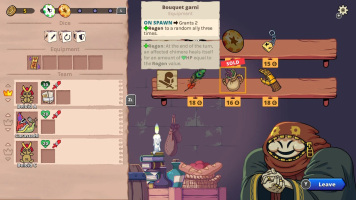Official Review
Dicefolk's story is pretty basic. A girl named Alea, a member of the titular folk, discovers she can use her powers to tame and befriend powerful creatures called chimeras which roam the land. Using this newfound ability, Alea sets out on a quest to battle an evil wizard who was sealed away years ago, hoping to stymie his dark influence and bring peace to the world. Those of you looking for a lot of narrative elements in a roguelite may be disappointed at the relatively thin worldbuilding and plot here, but we didn't feel that the lack of a strong storyline took away much from the core monster battling.
A typical run in Dicefolk tasks you with making it past three floors of a dungeon, each with a random assortment of combat encounters, merchants, and events to uncover. You technically only have to beat the boss of each floor to move on to the next one, but it's rarely that simple given that you're initially not shown where the boss is on the map and the path to get there isn't a direct shot. There's thus a little bit of planning and strategy that has to go into how you approach each floor, weighing the risks and benefits of which events and combat encounters you choose to engage in. That shop on the edge of the map may have an item that'll perfectly synergize with your build, but is it worth the fight you'll have to win to reach it? Such choices always feel meaningful because there are consequences, good and bad, that come from your choices.
Combat in Dicefolk reminds us a bit of rotation battles from the Pokémon series—there can be only up to three chimeras on either team at once, but only one at a time can be in the active 'lead' position. Though the lead is the only one who can directly attack for that turn, there are some conditions in which one or both chimeras on the backline can get in an attack, such as one we favored in early runs which would squeeze in a free attack as soon as all dice for that turn were used up. Additionally, the two chimeras on the backline aren't completely immune to damage; although the leader generally can only attack the other leader, there are a slew of moves that can be used to bypass this restriction.
Rotation itself is used as a very clever mechanic, wherein positioning and the timing of that positioning are just as important as the actions you take when in place. We had a chimera on some runs which would get in a free attack at the end of the turn, but only if it was rotated out of the lead position beforehand. Another chimera had an item that would grant it a strength buff every time it was rotated into the lead position, but it would receive a slightly smaller strength debuff when rotated out. We appreciated the additional layer of strategy that such combat effects added to battles, as you're often given much more to consider than who should be in the lead.
You won't necessarily be able to rotate your team every turn, however, as the potential actions available are decided semi-randomly by dice rolls, introducing a nice amount of chance to each round without completely leaving you out of control. You start out with three dice for your team, each of which locks in one of six actions—such as rotating in a specific direction or attacking—after they've been rolled at the beginning of each turn. Each die generally has a 'theme', such as offensive actions or support actions, but you can modify the actions mapped to their faces every now and then between battles to expand their usefulness.
Some may balk at the thought of a turn-based RPG with random actions each turn, but we enjoyed how this places a little more emphasis on strategy that takes place outside of combat. You can optionally upgrade your dice with new, more powerful actions via a merchant on the world map, and there's always some deliberation over which die that newly purchased action should go on. There's no avoiding the reality that you'll sometimes just get a bad roll, but that's all part of the importance of tailoring your dice configurations to your unique team and playstyle. With time, you get more of a 'build' going that enables ways to get new utility out of your dice, and you can always revise them along the way to better match the way your team is coming together.
Another fascinating gameplay mechanic is found in the way that actions for a turn are ordered. At the beginning of each turn, Alea doesn't just roll dice that determine her team's actions, she also rolls a couple that decide what the enemy team will do. Once rolled, it's then up to you to decide when each action takes place. You can't start the next turn until you've activated all the enemy team's dice, but you can plan around when their actions will trigger to give your team the edge.
For example, the enemy team may roll a "Clash Attack", which means that the team member they attack will strike back. To ensure you benefit from this when triggered (and assuming you rolled the necessary dice), you could first choose to spend a die to rotate your hardest-hitting chimera to the lead position and activate the "Guard" ability with another die, completely mitigating any damage for one attack. So, rather than trading blows, you instead manage to get a free heavy attack on them.
We loved getting to decide the actions of both teams, as it forces you to think through the battle from both sides and consider all the potential ways that the turn could play out. There's no escaping the enemy's actions, but having the knowledge of what's coming and the freedom to determine when it comes gives you a lot more agency to shape turns accordingly.
All of this is to say, Dicefolk has an impressively designed battle system with a lot of strategic depth. There are a lot of factors to consider, from individual turns to a more high-level view as you're slowly building your team throughout the run. Player choices are meaningful without feeling overwhelming, while the infusion of random elements keeps each encounter feeling dynamic without being too chaotic.
As for the monster-catching element, things are a little more straightforward than similar systems found in Pokémon or Shin Megami Tensei. On each floor, there are three shrines that randomly generate a chimera from your available pool, and adding one is as simple as selecting which you'd like. However, you can only take one chimera per floor, and the options aren't revealed until you've discovered all three shrines. You could just grab the first, but you will never know if something better might've been an option had you waited. On the other hand, a chimera currently on your team may be knocked out or close to it and you're all out of revives, which means you're much less likely to survive the necessary battles to make it to the other shrines.
We enjoyed this risk/reward system when it comes to chimera acquisition, as you're inevitably going to have to give something up. Not only do you have to permanently release a current chimera on your team to make room, but every decision to not take one is final. This makes every new chimera opportunity feel like an event.
Dicefolk is overall on the 'easy' end of the difficulty spectrum—we nearly beat the final boss of our very first run—but those of you who appreciate metaprogression elements will be pleased to know that there is some progress carryover to make future attempts easier. After a run is finished (win or lose) your progress will be converted into experience points for the class of chimeras from that run, unlocking new chimeras, loot, events, and more for the pool to potentially appear in future attempts. You're still at the mercy of RNG regarding which chimeras show up at the shrines or what items appear in a floor's shop, but we appreciated that sense of forward progression regardless of a run's outcome.
The only complaint we have about Dicefolk, which is more of a nitpick, is that it feels like it lacks some party growth elements that would make runs that much more engaging. Chimeras can't level up or grow throughout a run—they simply come 'as is', which makes them feel like static tools you modify with items instead of living monsters you're recruiting and training. It would've been cool if there were a way for them to gain new skills or power up existing ones after winning enough battles, or even better, if some of them could evolve into a more powerful form after they accrued enough experience or met specific conditions. Still, while this lack of individualized progression feels like a missed opportunity, it just highlights that there's plenty of room for expansion and new ideas in this gameplay system should there ever be a Dicefolk 2.
As for its presentation, Dicefolk executes a beautiful art style somewhat reminiscent of '80s cartoons. Chimera designs may not be anywhere near as iconic as Pokémon, but most of them are colorful and creative in their own way. Our favorite was a schnauzer decked out with seaweed instead of hair. Meanwhile, biome designs can be a little plain—of course there's a poison swamp—but we enjoyed the attention to little details, such as a breeze occasionally blowing across grassy plains in the background.
Conclusion
Dicefolk is an excellent new addition to the enormous roguelite genre that manages to feel fresh without getting too far away from the core ideas that make these sorts of games so addictive and popular. An attractive art style, strong combat system, and meaningful player choices make this one a brilliant addition to the library for anyone looking for another great roguelite on Switch. Even if you aren't typically a fan of this genre, we'd suggest you at least consider this as a possible entry point. Dicefolk is approachable without being patronizing and it's tons of fun once you get a grasp of its various quirks.


